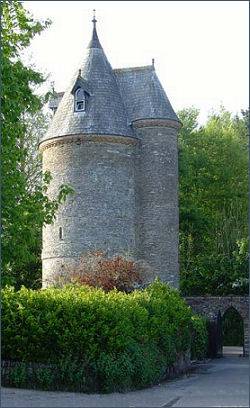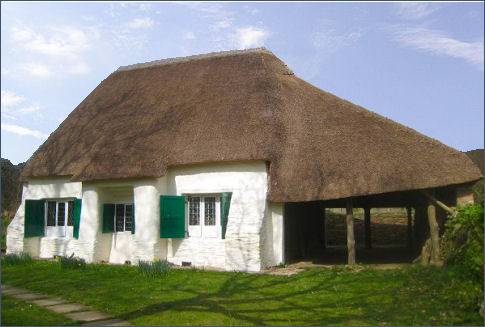Feock
OS Grid ref:- SW 82 38

The pretty village of Feock is situated about 5 miles (8 km) south of the town of Truro and lies at the head of Carrick Roads on the River Fal.
The village is known in Cornish as Lannfyek, the small village Church stands in the centre of Feock and is dedicated to Saint Feoca or Fioc, an obscure saint about whom little is known. The church has a thirteenth century tower and font, the remainder of the building dates from the nineteenth century. Unusually, the pyramidal shaped tower (pictured left) stands some metres away from the main church. The Norman font of Catecleuse stone is decorated with trees of life panels and there is painted coat of arms of King Charles I dating from 1638. The Reredos was given by The Reverend Philpotts and based on ones he had seen in Florence, it has crocketted pinnacles over battlements with a cusped ogee arch at the centre and flanking pointed arched panels with the ten commandments.
The church has the distinction of being the last church to conduct its service in the Cornish language. In 1640, the sacrament was still being administered to the congregation by the vicar in Cornish as the area's populace could not understand English.
 A medieval cross stands in the churchyard , which is believed to be in its original location. It is a good example of a wheel headed cross and is unusual in showing signs of transition from an early medieval style to the later Gothic style. The cross is a rare example of a churchyard cross from the later medieval period, and is carved from elvan, rather than the more usual granite.
A medieval cross stands in the churchyard , which is believed to be in its original location. It is a good example of a wheel headed cross and is unusual in showing signs of transition from an early medieval style to the later Gothic style. The cross is a rare example of a churchyard cross from the later medieval period, and is carved from elvan, rather than the more usual granite.
Fishing for Oysters in the River Fal is an age old tradition which is still followed by successive generations of several Feock families. Oyster Boats may be seen on the river as they sail back and forth in the winter months when the oyster beds are usually being dredged. It has been recorded that in a good season, a fleet of thirty to forty of the boats can be working in this area and around nearby Restronguet Point.
On the edge of the village lies the Trelissick estate, including the stunning Trelissick Garden, (right) which has been owned by the National Trust since 1955 when it was donated by Ida Copeland following the death of her son Geoffrey, a stained glass memorial, bearing the Copeland Crest, is displayed in the village church. The gardens feature Hydrangeas, Rhododendrons, Camellias and 500 acres of parkland and riverside woods overlooking the River Fal and Carrick Roads.
 The garden is noted for its year round colour and superb views of the highly attractive Fal estuary, one of the most beautiful estuaries in the country and Falmouth harbour.
The house, which dates to the eighteenth century is owned and lived in by the Copeland family and is not open to the general public.
The garden is noted for its year round colour and superb views of the highly attractive Fal estuary, one of the most beautiful estuaries in the country and Falmouth harbour.
The house, which dates to the eighteenth century is owned and lived in by the Copeland family and is not open to the general public.
The King Harry Ferry in the village transports cars across the River Fal to the nearby village of Philleigh on the beautiful Roseland Penninsula. It is one of the few remaining car and passenger chain ferries in Britain.
The characterful, thatched pub and restaurant, the Punchbowl and Ladle, dates back to the fifteenth century, during the seventeenth century it was a hostelry for travellers and mariners crossing the river Fal on the King Harry Ferry. Legend has it that part of the building was employed as a customs house, and the original fireplace in the bar was used to destroy confiscated contraband! The Punchbowl and Ladle serves an extensive menu and fine ales. The nearby thatched fifteenth century Smuggler's Cottage once accommodated General Eisenhower, though nowadays serves lunches and drinks in its riverside gardens.
At the Come-to-Good crossroads stands a thatched cottage built as a Society of Friends or Quaker meeting house in 1710 (left). The charming exterior features thatch, whitewash and leaded windows. The 'House of Friends' even has roofed space for the worshippers' horses.